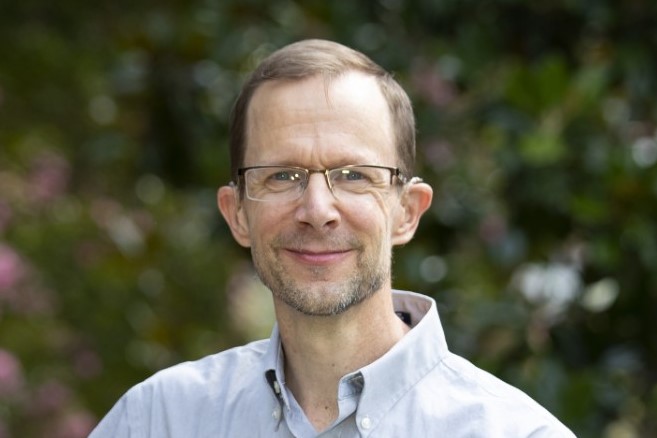Teaching History Through Deaf Experience

Christopher Krentz is an Associate Professor with a joint appointment between the English Department and the American Sign Language Program in the College and Graduate School of Arts & Sciences at the University of Virginia. Mr. Krentz serves as Director of Diversity, Equity, and Inclusivity for UVA's English Department and teaches a seminar class on the history of the American Deaf Community, which he summarizes for us as we recognize Deaf History Month.
Why study deaf people in America’s past? “History of the American Deaf Community,” a seminar I teach that is cross-listed between UVA’s American Sign Language Program and the History Department, offers some revealing answers. Focusing on the emergence and growth of a community of sign language users, the course illumines the paradoxes of minority identity in the United States, the overlooked experiences of those who used an unrecorded language, the grievous effects of an insistence on normality, and much more.
My initial motive in offering the course and pursuing research in deaf history is undoubtedly personal: I am “late-deafened,” meaning that I’ve gradually lost much of my hearing since I was a child (I teach with a sign language interpreter). When I discovered the signing deaf community shortly after graduating from college, I became curious: How did something so rich and interesting come about, and why is it so often ignored?
As I offered the class, I came to see how studying deaf history illumines not only a specific minority group but also the center of American cultural history. Among the details we cover:
- Approximately 94% of deaf people have hearing parents, meaning they are born into families that do not know or understand their situation. Before deaf education started in the early nineteenth century, most deaf Americans lived isolated from each other and uneducated.
- Exceptions existed. In Martha’s Vineyard in the eighteenth century, isolation, intermarriage, and a recessive gene for deafness led to a signing village where many hearing families included deaf people. Deafness was largely destigmatized. Meanwhile, in New Jersey and Maine, deaf families with a dominant gene for deafness created a strong deaf identity where both parents and children signed.
- The first permanent school for deaf students was founded in Hartford, Connecticut, in 1817. It was part of the larger impulse that gave rise to new free schools for impoverished children, schools for blind students, prisons, and hospitals during the Second Great Awakening.
- One of the co-founders of the school, Laurent Clerc, was a deaf teacher from France. In 1818, he wrote an address for the Connecticut legislature where he positioned deafness within the spectrum of human diversity. “Why then are we Deaf and Dumb? I do not know, as you do not know. . .why there among the human kind, white, black, red, and yellow men.”
- Deaf education was new and a source of fascination. Clerc received an invitation to visit President Monroe in the White House. When he went to Congress, speaker Henry Clay stopped the proceedings so representatives could meet Clerc, who communicated with them in written French and English.
- Schools for deaf students were quickly founded in many states, including the Virginia School for the Deaf and Blind in Staunton in 1839.
- Still, some educated deaf adults felt frustrated with the discrimination and lack of opportunity they encountered. In the 1850s, one proposed forming a state for deaf people in the West where they could run their own affairs. Although the idea was ultimately rejected, it generated a passionate debate in a deaf journal.
- In the midst of the Civil War in 1864, Abraham Lincoln signed the charter for the National Deaf-Mute College, which is located in Washington D.C. and is today called Gallaudet University.
- In the late nineteenth century, hearing educators led by Alexander Graham Bell (who had a deaf wife and deaf mother) tried to ban sign language from deaf education and teach articulation and speech-reading. The movement, called oralism, was closely aligned with eugenics and fears that foreign immigrants were changing “American” ways.
- In the early twentieth century, the advent of film allowed deaf people to record themselves signing for the first time, giving them a new means to express their language and culture.
- In 1965, a hearing professor at Gallaudet University, William Stokoe, identified American Sign Language (ASL) as a language, helping to usher in a period of deaf pride and cultural celebration among deaf people that paralleled Black pride and other movements of the 1960s.
These are a few of the lessons that the subject has to teach all of us.

The class illustrates the maxim: “The margin illuminates the center.”
- A Revolution in the Air: The Wright Brothers Take to the Sky on December 17, 1903
- Musings on National Violin Day
- Making the Promise Real: How a UN Tax Convention Can Fulfill the UNDHR’s Vision
- UVA Club of Atlanta: Virtual Pilates Class
- UVA Club of New Orleans: Hoo-liday Party
- Virginia Club of New York: Big Band Holidays Jazz Outing